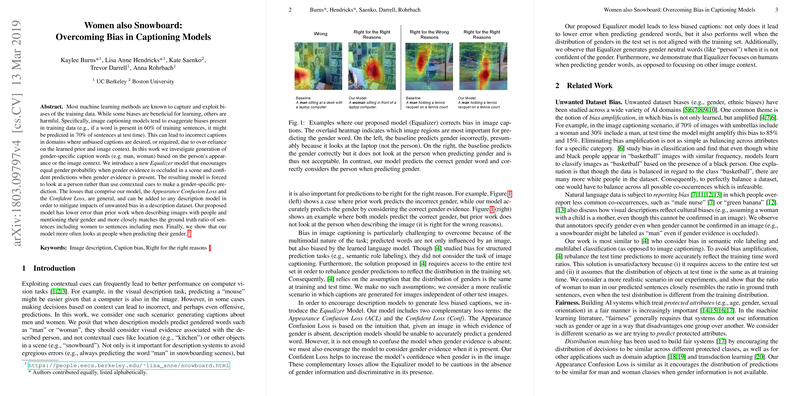Overcoming Gender Bias in Image Captioning Models
The paper "Women also Snowboard: Overcoming Bias in Captioning Models" addresses the prevalent issue of bias in machine learning models, particularly focusing on the task of image captioning. The authors highlight the problem where image captioning models tend to amplify biases from the training data, resulting in skewed generation of gender-specific terms. This paper introduces the Equalizer model, designed to mitigate such biases, ensuring that captions more accurately represent gender distribution in images.
Research Context and Problem
In many computer vision systems, contextual cues are utilized to improve performance. However, this reliance can lead to biased or incorrect predictions, especially for gender-specific words. Current models may, for instance, disproportionately predict the word "man" in snowboarding scenes, simply due to training data bias, rather than visual evidence. This research seeks to address the over-reliance on contextual information when generating gendered language in captions.
Proposed Framework
The Equalizer model is the core contribution of this paper. It incorporates two novel loss functions:
- Appearance Confusion Loss (ACL): This loss function discourages the model from making gender-specific predictions when gender cues are not evident in the image. It works by ensuring that in the absence of gender-specific visual evidence, the model remains "confused" and does not lean towards predicting a gender.
- Confident Loss (Conf): This complements the ACL by boosting the model's confidence in making gender-specific predictions when there is clear visual evidence of gender in the image.
These losses are integrated into the usual image captioning framework, promoting a balance between caution and confidence in gender predictions.
Results
The paper presents evaluation results on datasets derived from MSCOCO with varying gender distributions. The Equalizer model demonstrates reduced error rates in gender classification, more closely matching ground truth distributions. Specifically, it achieves lower error rates and a more accurate prediction of gender ratios compared to baseline models, even when the distribution of gender-specific terms at test time differs from the training data.
Moreover, the model performs better at being "right for the right reasons"—using appropriate visual evidence from the person, rather than scene context, when making gender predictions. This is validated using techniques like Grad-CAM, indicating that Equalizer focuses on human subjects when predicting gendered words.
Implications and Future Work
This research has significant implications in the field of AI ethics and fairness. By reducing bias in automatic descriptions, systems become better aligned with human descriptors and cultural fairness standards. The paper suggests that while this paper focuses on gender, the framework could be extended to address other types of biases.
The challenges of balancing dataset biases, ensuring fairness, and explaining AI decisions remain open research areas. Future directions could explore similar techniques across different demographic attributes or in other contexts where bias and fairness are critical concerns.
Conclusion
In summary, the paper provides a robust framework for addressing gender bias in image captioning models. By focusing on contextual cues and introducing specific loss functions, the Equalizer model stands as a valuable tool for generating fairer and more representative machine-generated descriptions. This contribution is a step forward in the larger goal of creating unbiased AI systems.
